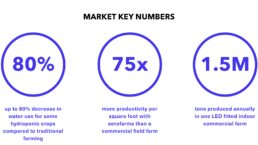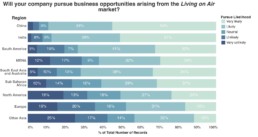The use of advanced technologies to produce food without soil, and with reduced reliance on water and fertiliser, will make it possible to grow food in new areas. Soil-free agriculture presents an opportunity to save water and give tired soils a chance to regenerate. The opportunity space includes a range of supporting products like LED lighting and renewable energy technologies.
Soil-free agriculture (also called soilless) presents one of the strongest opportunities for scientific, economic, and technological advancements in the field of agriculture of the last 200 years. Originally invented to produce out-of-season crops, this technology can help to regenerate soils in times of land pressure and degradation. Soil-free agriculture offers higher yields than traditional agriculture, uses water more efficiently, and provides alternatives to toxic soil sterilisation, decreasing risks of soil-borne diseases. Even more promising, soil-free agriculture can take the form of indoor or vertical farming, and is suitable for dense urban environments. The benefits of soil-free agriculture are manifold. It permits more food to be grown locally, lowering emissions from transport and reducing food moving costs. A more stable food supply will help reduce price fluctuations and food waste, while allowing a variety of foods to be produced any time of year.

Products and Services
Products and services in the soil-free agriculture market include the necessary input into production, including alternative growth media; LED lighting for indoor cultivation; technical and advisory services; and advisory for soil-free agriculture. Products also include towers to grow plants vertically or shelves to maximise the space for production, both of which can be acquired with built-in LED lighting. Renewable energy is an important component in this market, as it lowers emissions from lighting used in indoor soil-free farming. Products in soil-free agriculture include solar panels that provide power to submersible pumps. As solar-powered systems continue to drop in price, the costs of operating an indoor soil-free garden will also decrease, making these technologies even more attractive.
Market Size and Demand Drivers
A number of factors are driving soil-free agriculture. First, global urbanisation is driving demand for more locally produced food. Second, the increasing rate of extreme weather events coupled with decreasing soil fertility are creating demand for producing food in more controlled environments. Third, there is a growing movement around self-sufficiency, which brings food production into areas without land available for cultivation, such as cities. On the whole, alternative soil solutions are becoming a real business opportunity. Aquaponics alone is estimated to be worth 1 billion USD by 2020. The worldwide market value of food produced without soil (this covers both soilless and hydroponically produced food) will show sustained strength with a 6.5 percent compound annual growth rate (CAGR) from 2013-2018, beating the IMF estimated growth forecast of 3.6 percent for 2014. Producer value will increase from 17.7 billion USD to 24.3 billion USD
Survey Findings
The financial sector is ready to play an active role in developing the market for soil-free agriculture, as leaders in this field believe there already exists a substantial capacity to grow this market. Leaders in this sector also believe the market will create positive change.

Europe is the region where the market is most ready to mature, as leaders here rate it particularly positive. The same goes for the countries belonging to the very high Human Development Index category.
Leaders in China are confident their country has the capacity to develop this market. They rate this market opportunity very positive with respect to economic capacity and also high on the political capacity parameter, while they rate the technological capacity lower. Respondents in most other regions do not believe the capacity is in place to pursue this opportunity. In particular, leaders in India and Other Asia (Japan and Russia) indicate there does not yet exist sufficient capacity in their regions to pursue the market for soil-free agriculture.

Globally it is one of the opportunities with the weakest business case in the eyes of all the leaders asked. Regionally, leaders in the water-scarce MENA region believe the opportunity will have the most positive impact. However, at a global level, the data points to a need to incentivize business to become actively involved in developing this market. Business in China is the exception to this global trend, where leaders rate the business case higher than in the rest of the world.
The soil-free agriculture market does not appear to be high on the agenda of civil society, or politicians. However, the strongest advocates are found in China.
This market was surveyed globally in 2016 by more than 5500 leaders from both the public and private sectors. The survey was conducted in collaboration with the research company YouGov. The survey results were originally published in the Global Opportunity Report 2017.

